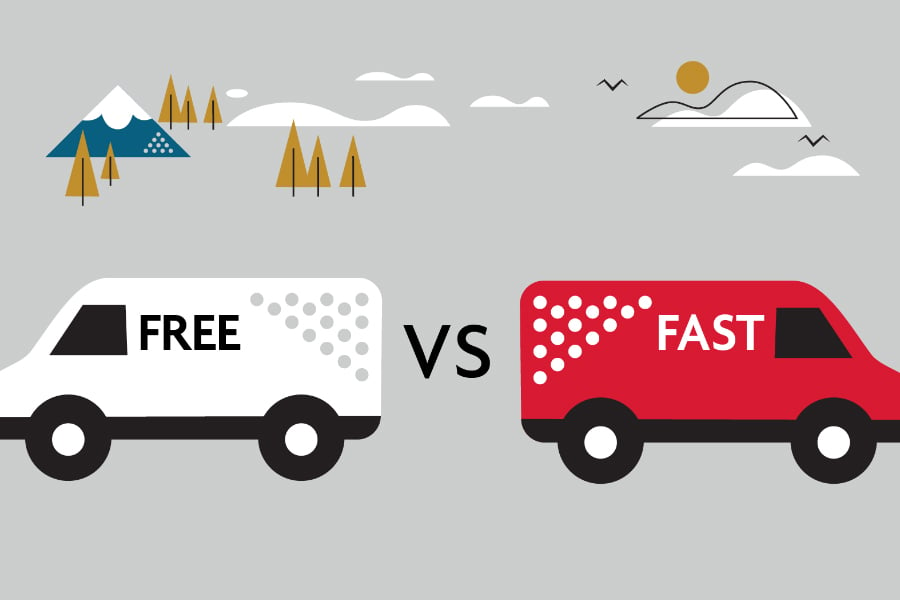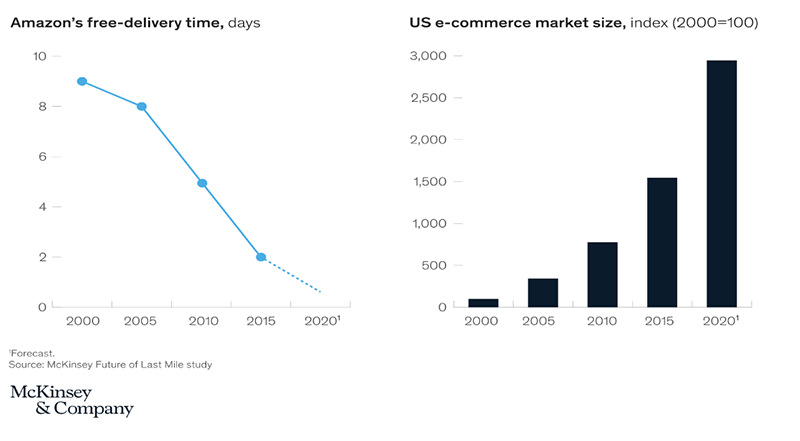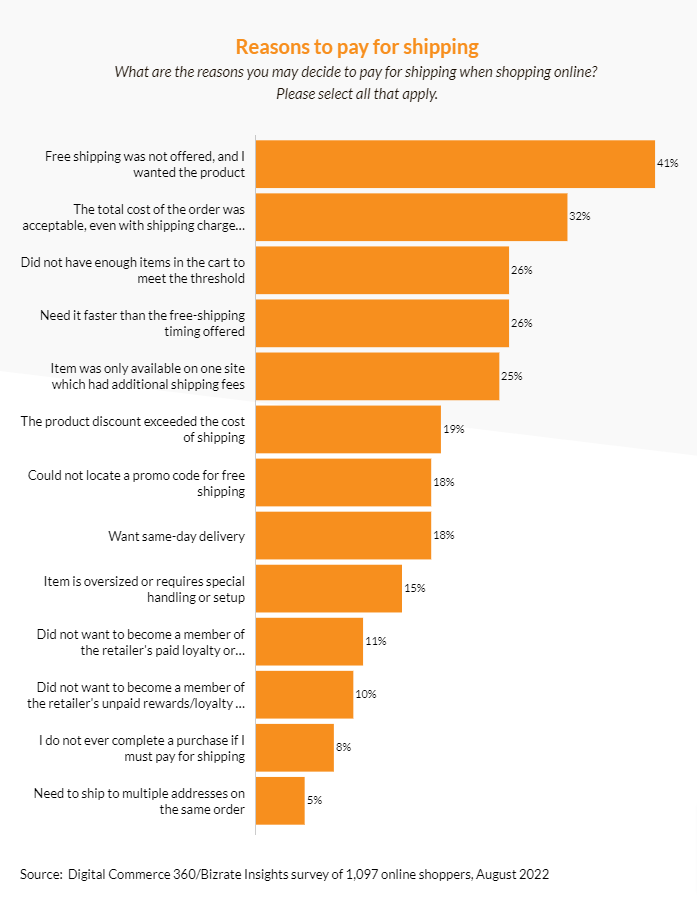Logistics
Industries
Technology & Innovations
E-commerce
E-commerce Fulfillment Services
Lease & Maintenance
Semi Trucks
Logistics
E-commerce
Lease & Maintenance
Buy Used Trucks

[Updated post from April 27, 2021]
In e-commerce, we've grown used to hearing all about the importance of fast and free shipping.
Brands are constantly told that online shoppers expect orders to be on their doorstep faster than ever before. And not only that – they also expect delivery for free.
But is this actually true?
The tension between cost versus speed is not new in e-commerce, with brands constantly trying to offer competitive deals without affecting their bottom line. So, if it's a matter of choosing between free OR fast shipping, which is a better value proposition for consumers?
Free shipping sounds like a simple concept, but there are a variety of ways that brands can offer free shipping to optimize cost and convenience. Some brands may set a minimum purchase threshold value to avoid making a loss on smaller orders or create a loyalty program where people pay an annual fee to access unlimited free shipping. Alternatively, free shipping might be used as a limited-time promotion to stimulate buyer urgency to purchase.
In sum, offering free shipping does not mean a one size fits all strategy. Brands need to consider carefully what their goals are and which approach to free shipping is going to bring them the results they want.
Consumer perceptions of what is considered expedited shipping are in flux as online retailers push to expedite their delivery times. The so-called 'Amazon effect' has had a massive influence on expected delivery time in e-commerce, with many shoppers viewing two-day shipping or less as the norm.

We can see from this graph how Amazon's free delivery timeframe has continued to fall sharply over time, putting the squeeze on other e-commerce businesses to follow suit if they want to stay competitive. But high shipping costs for faster shipping can put brands in a tough position. There is a direct correlation in e-commerce between unexpected shipping costs and high cart abandonment, but absorbing the total cost of expedited shipping simply isn't possible for many businesses.
Even Amazon has recently moved to revise its generous fast and free shipping options, with free same-day delivery now only available to Prime members on orders over the minimum purchase amount of $25, while Prime memberships themselves have experienced price hikes in a variety of regions. If brands want to offer fast shipping, it's important to be aware that it may not be possible to avoid passing on at least some of the shipping cost to your customers.
So, while free AND fast shipping might seem like the holy grail in e-commerce, it's less common than we might think. The cost of fleet maintenance, running fulfillment centers, and expensive logistics software to handle such rapid delivery times is the primary reason why even e-commerce giants like Amazon are moving away from this approach.
So, if it's a choice between free shipping and fast shipping, which one should brands be prioritizing?
Before the pandemic, it was clear that delivery speed was becoming a more important competitive differentiator in e-commerce. 96% of customers consider 'fast' delivery to mean same-day delivery, highlighting that brands have an uphill fight on their hands to impress customers.
But while the definition of fast delivery may have changed over time, this doesn't necessarily mean that this is what online shoppers are prioritizing.
During COVID-19, online shoppers were forced to adjust to longer delivery timeframes due to supply chain issues, with 45% of consumers saying they accepted longer delivery times during 2020 than they did in the past.
Fast forward to 2023, and consumers continue to be less concerned about shipping speed, - but they are more worried about cost.
According to Shippo's 2023 State of Shipping Report, 75% of consumers who were given the choice between a free and fast shipping offer would choose free shipping. This also applies to the return process, with 45% of respondents saying that the availability of free return shipping was important to them.
Looking into the scenarios where consumers are willing to pay for free shipping, it's clear that speed isn't the top priority for most. 41% of consumers will pay for shipping for a product they want, and 32% will proceed with an order if they find the shipping cost reasonable. Only 26% of shoppers will pay for shipping because they need their order in a faster timeframe than the free shipping option allows for. Just 8% were willing to pay for same-day delivery, highlighting that such rapid shipping and delivery speeds have limited appeal.

As inflation and price hikes continue to bite, consumers are looking for ways to save money on their online purchases wherever they can, and the shipping process presents the most obvious place to economize.
However, a successful shipping strategy involves far more considerations than just speed and cost; you also need to think about the impact that your chosen shipping options have on the customer experience. Here are some additional considerations that e-commerce brands should take into account when pursuing fast and free shipping:
When the COVID-19 pandemic caused storefronts to close their doors in 2020, retailers were forced to pivot to keep serving their customers. Physical stores were transformed into strategic pick-up points for online orders. Curbside pick-up and BOPIS (Buy Online, Pick-Up In-Store) skyrocketed in demand, with stores such as Dick's Sporting Goods seeing 75% of its online orders being fulfilled by stores by Q3 of 2020.
BOPIS and curbside pick-up continue to see widespread use because they give consumers the best of both worlds. It's faster than conventional home delivery and usually comes at no extra cost to the customer. This has had a profound effect on how consumers perceive delivery speed, with people more likely to choose in-store pick-up when they need an item urgently.
Considering that an in-store order can be ready for pick-up in as little as a couple of hours, BOPIS is the closest that consumers can get to instant gratification in e-commerce - even outstripping the pace of same-day delivery.
Store-based fulfillment methods offer brands an alternative to expensive shipping options that still meet consumer demand for speed and reliability. If BOPIS or curbside pickup is available to your business, investing in these capabilities could be of greater benefit in the long term than paying for fast shipping.
A positive delivery experience isn't just a matter of speed and price; growing evidence shows that the post-purchase experience from end-to-end has the most influence on how customers feel towards a brand.
For example, surveys have uncovered that reliability is also a growing priority for online shoppers. According to a survey by route planning software Circuit, consumers expressed a preference for guaranteed delivery times over fast delivery, so they can prepare to be home when their order arrives.
And even when delivery occurs on time, an absence of proactive support following a purchase can add friction to the customer experience. This is especially critical for retailers who are using slower delivery speeds, as the sizeable lag between purchasing and delivery can breed anxiety if communication is lacking.
No matter whether retailers prioritize speed or cost, the post-purchase experience offers a valuable opportunity to build a rapport with your customers. Proactive order updates via email and SMS, real-time order tracking, and customer surveys all shape how customers view their shipping and delivery experience.
Choosing whether to offer free shipping or fast shipping is a false economy when brands can decide to offer both.
The biggest weakness of the fast vs. free shipping argument is that some online purchases are more time-sensitive than others. We might be happy to wait a week or more for a big-ticket item like outdoor furniture, but we want essentials like groceries or personal care products to arrive ASAP.
This is why there's no such thing as the perfect shipping method. While some customers will be happy if you offer free shipping, others will be frustrated if a speedier service isn't available. By offering multiple delivery options at different speeds and price points, your customers will find the ideal delivery method that works for their needs.
So, is offering free or fast shipping better for business?
The answer: It depends.
While many customers undoubtedly prefer free shipping, others will prioritize speed even if it comes at an extra cost. When people are shopping online to meet many different needs, it's only logical that they want diverse shipping options to match. The continuing popularity of store-based pickup also signals that the flexibility to choose is what appeals most to customers.
Moreover, the dichotomy of price versus speed ignores other parts of the online shopping experience that also influence customer satisfaction. If consumers get little or no communication following a purchase, they're unlikely to shop with that brand again – no matter how fast or affordable the shipping method.
As shipping becomes a bigger battleground for customer loyalty, retailers need to think about their shipping strategy as more than just an exercise in logistics. It's also a customer experience strategy that presents a key touchpoint to surprise and delight consumers in innovative ways.